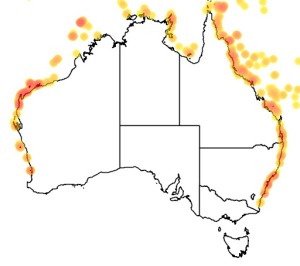Colours
Distinguishing features
A small elongate fish that swims very quickly using the pectoral fins. The fish is mainly green with pink lines on the head and a distinct pink patch in the pectoral fin. The terminal phase male is similar but with a blue wash over the head region and can change colour to all blue. Juveniles have a dark spot at base of tail and another in the middle of the dorsal fin.
Size
- Up to 20 cm (Standard length)
Depth range
- Depth range data is not yet available.
Synonyms
Distribution
Distribution and habitat preferences
Usually near areas of hard coral cover in sheltered lagoonal habitats.
Can be found in most locations around the island.
Behaviour
The moon wrasse is common throughout the GBR, and is a very successful generalist feeder, able to occupy a wide range of habitats. It feeds primarily on small invertebrates picked from the substratum, but it will also feed on plankton, and the eggs of demersal nesting damselfish. It has also been observed to coordinate group hunting behaviour, where small packs of moon wrasse will isolate individual Cardinalfish juveniles from schools, and then attack and eat them. This species spawns in groups around sunset, where the brightly coloured males display to the duller females. Like all wrasses, this species changes sex from female to male as they get older.
Web resources
References
- Ackerman, J. (2004). Geographic variation in size at age of the coral reef fish, Thalassoma lunare (Family Labridae): a contribution to life history theory, Ph.D. thesis, James Cook University. LIRS catalog number 927.
- Allan, B.J.M., B. Illing, E.P. Fakan, P. Narvaez, A.S. Grutter, P.C. Sikkel, E.C. McClure, J.L. Rummer and M.I. McCormick (2020). Parasite infection directly impacts escape response and stress levels in fish. Journal of Experimental Biology, 223: jeb230904. LIRS catalog number 2445.
- Arnal, C. (2000). Ecologie comportementale de la symbiose poisson nettoyeur/ poisson client: motivations et honnêteté, Ph.D. thesis, University of Perpignan, France. LIRS catalog number 637.
- View all references









